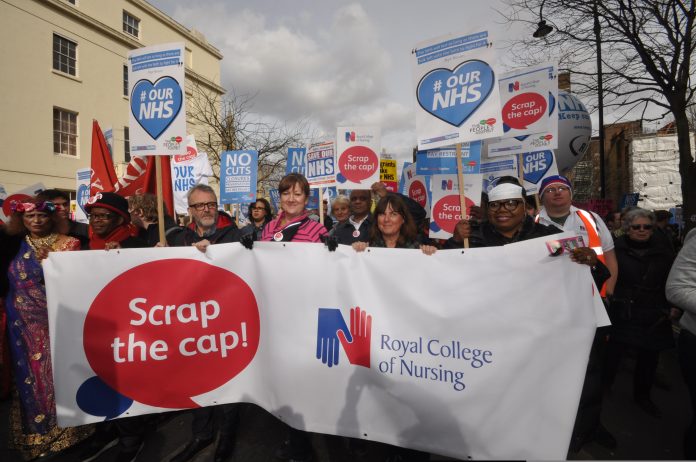
‘THESE figures reflect the stark reality facing NHS trusts resulting from the combination of relentless increases in patient demand, 100,000 staff vacancies and the legacy of a decade of austerity.’
That was the first response of Nick Ville, the NHS Confederation’s Director of Policy, following NHS Improvement’s latest quarterly performance and provider sector report representing organisations all across the healthcare sector.
He then continued: ‘NHS Improvement’s report shows that NHS staff are working harder than ever, with more patients being treated whilst delivering efficiency savings.
‘Despite this the NHS continues to be unable to meet its performance targets, as the funding available has not kept pace with the demands on front-line services. This has led to the financial performance of NHS trusts being more than £250 million behind what was planned.
‘The good news is that the new Five Year funding settlement and the NHS Long Term Plan provides stability and a welcome vision for the future. But we should be under no illusions about the scale of the challenge facing the NHS to get back into the black, meet key waiting time targets and address the staff shortages holding the service back.’
He continued: ‘These latest figures mark the end of winter, and the NHS has come through in better shape than we could have hoped. More patients are being treated than ever before despite huge demands being placed on front-line services.
‘This is credit to NHS staff, who go above and beyond every day for their patients, and to the extra funding and planning that went into this winter’s preparations.
‘But we should all be clear that this is not a sustainable way to run a health service. Staff have been put under immense strain and we must not put them in this position again.
‘That’s why the NHS Long Term Plan and new funding settlement is so crucial. We must put the foundations in place to ensure we are able to meet the needs of a changing, older population with more complex health needs.’
In her comments on the same report, the Royal College of Nursing’s (RCN’s) Acting Chief Executive Dame Donna Kinnair added:
‘It’s very disappointing that there are over 3,000 more nursing vacancies in the NHS in England than this time last year, despite repeated announcements by Ministers and the bodies that run the NHS that increasing workforce numbers is their top priority.
‘What’s more, the overall nursing vacancy rate of 11% announced by NHS Improvement today disguises far bigger shortages in individual areas such as mental health and learning disabilities, which are harder to recruit to.
‘The forthcoming Workforce Implementation Plan needs urgently to come up with a credible and costed proposal for increasing nurse numbers, and Ministers need to commit the resources to deliver it.
‘As a first move, we are calling on the government to invest at least £1 billion a year into nurse higher education, in order to increase the size of the workforce of the future.
‘The RCN is also calling for accountability for safe levels of nurse staffing to be enshrined in law’.
At this point last year (Q3, 2017/18), the number of vacant nursing posts was 35,934, a vacancy rate of 10.2%. Today’s figures for the same period a year later have increased to 39,148, a vacancy rate of 11%.
Funding reforms have meant that since 2017, students studying nursing no longer receive a bursary and instead take out student loans to cover their tuition fees (up to £9,250 a year) and for maintenance support (means tested up to £11,354 a year).
Figures released by UCAS on 7th February showed the number of applications to start nursing degree courses in England has fallen from 43,800 in 2016, the last year students received the nursing bursary, to 30,650 this year – a drop of over 13,000.
In addition, between 2016 and 2018 the number of students actually starting courses dropped by almost 1,000.
- Meanwhile BMA Scotland’s Health secretary Jeane Freeman reported that overall NHS staffing levels were up by more than 13,600 whole-time equivalent posts under the country’s current government.
‘We’re developing a comprehensive integrated health and social care workforce plan to help ensure that we have the right staff in the right place long into the future,’ she added.
‘This will be informed by our safe staffing legislation that we are currently taking through the Scottish Parliament – the first multidisciplinary workforce and workload planning legislation in the UK.’
However, BMA Scottish consultants committee chair Simon Barker said the issue of ‘hidden’ vacancies meant that the full picture wasn’t properly recognised.
‘Vacant posts are still being left out of these figures for various reasons. This just isn’t acceptable. Everyone agrees there is a problem, but you can’t expect to find solution if you don’t have the complete picture in the first place.
‘It is incredibly frustrating as a doctor to see ongoing reliance on statistics which are clearly deficient and don’t fully reflect the substantial challenge of working in Scotland’s NHS, and doing the very best you can to deliver care, yet being hamstrung by a lack of resources and staff.
‘Recently a great deal of time has been spent discussing how to improve waiting times. Clearly it is impossible to believe that sustainable solutions to deliver quicker care can be achieved while this situation persists.
‘You can spend anything you want on new equipment, but it will provide zero benefit without the skilled staff there to use it.’